OPEL CALIBRA 1988 Service Repair Manual
Manufacturer: OPEL, Model Year: 1988, Model line: CALIBRA, Model: OPEL CALIBRA 1988Pages: 525, PDF Size: 58.26 MB
Page 121 of 525
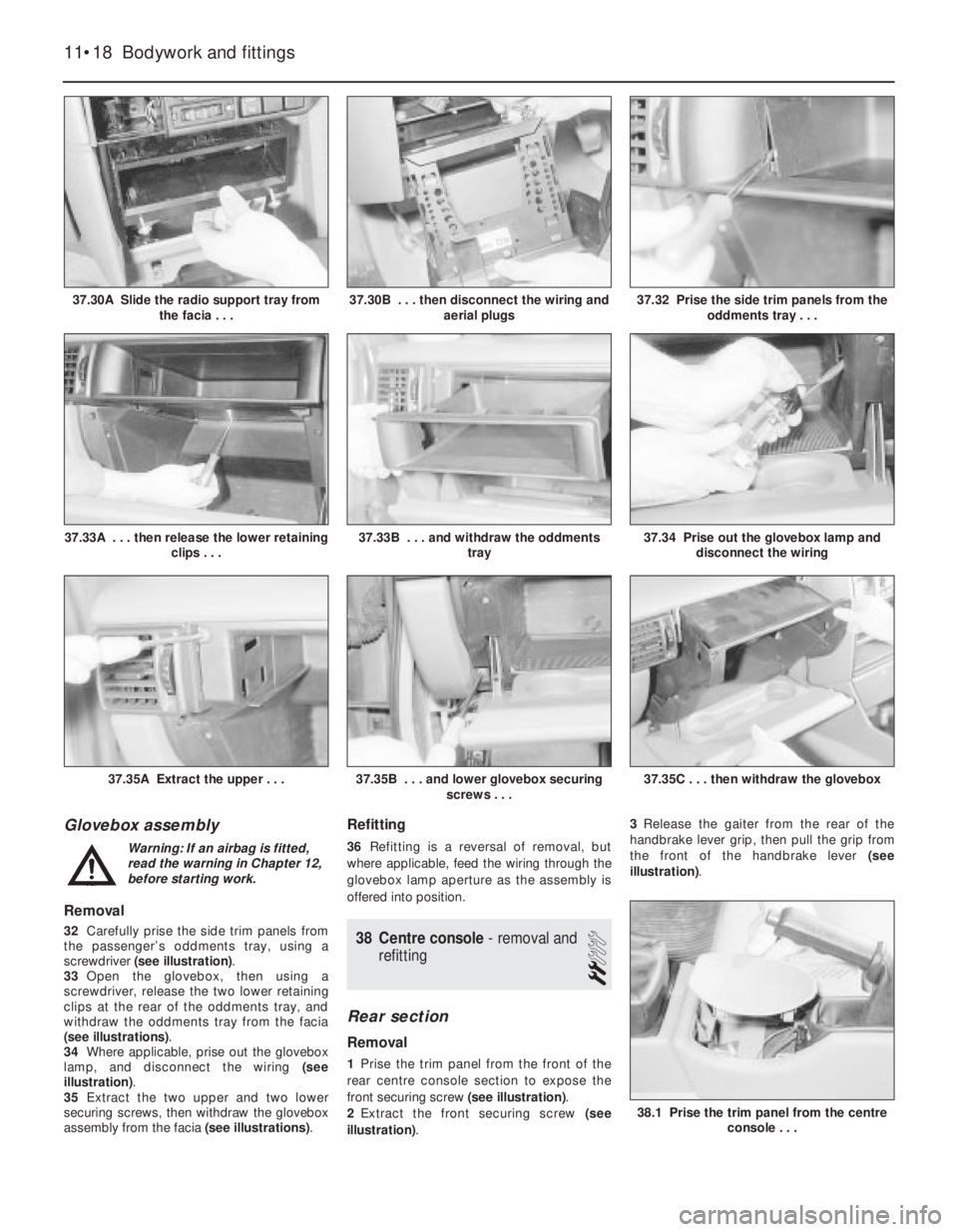
Glovebox assembly
Removal
32Carefully prise the side trim panels from
the passenger’s oddments tray, using a
screwdriver (see illustration).
33Open the glovebox, then using a
screwdriver, release the two lower retaining
clips at the rear of the oddments tray, and
withdraw the oddments tray from the facia
(see illustrations).
34Where applicable, prise out the glovebox
lamp, and disconnect the wiring (see
illustration).
35Extract the two upper and two lower
securing screws, then withdraw the glovebox
assembly from the facia (see illustrations).
Refitting
36Refitting is a reversal of removal, but
where applicable, feed the wiring through the
glovebox lamp aperture as the assembly is
offered into position.
38Centre console - removal and
refitting
2
Rear section
Removal
1Prise the trim panel from the front of the
rear centre console section to expose the
front securing screw (see illustration).
2Extract the front securing screw (see
illustration).3Release the gaiter from the rear of the
handbrake lever grip, then pull the grip from
the front of the handbrake lever (see
illustration).
11•18Bodywork and fittings
37.30A Slide the radio support tray from
the facia . . .37.32 Prise the side trim panels from the
oddments tray . . .
37.35C . . . then withdraw the glovebox37.35B . . . and lower glovebox securing
screws . . .37.35A Extract the upper . . .
37.34 Prise out the glovebox lamp and
disconnect the wiring37.33B . . . and withdraw the oddments
tray37.33A . . . then release the lower retaining
clips . . .
37.30B . . . then disconnect the wiring and
aerial plugs
38.1 Prise the trim panel from the centre
console . . .
Warning: If an airbag is fitted,
read the warning in Chapter 12,
before starting work.
Page 122 of 525
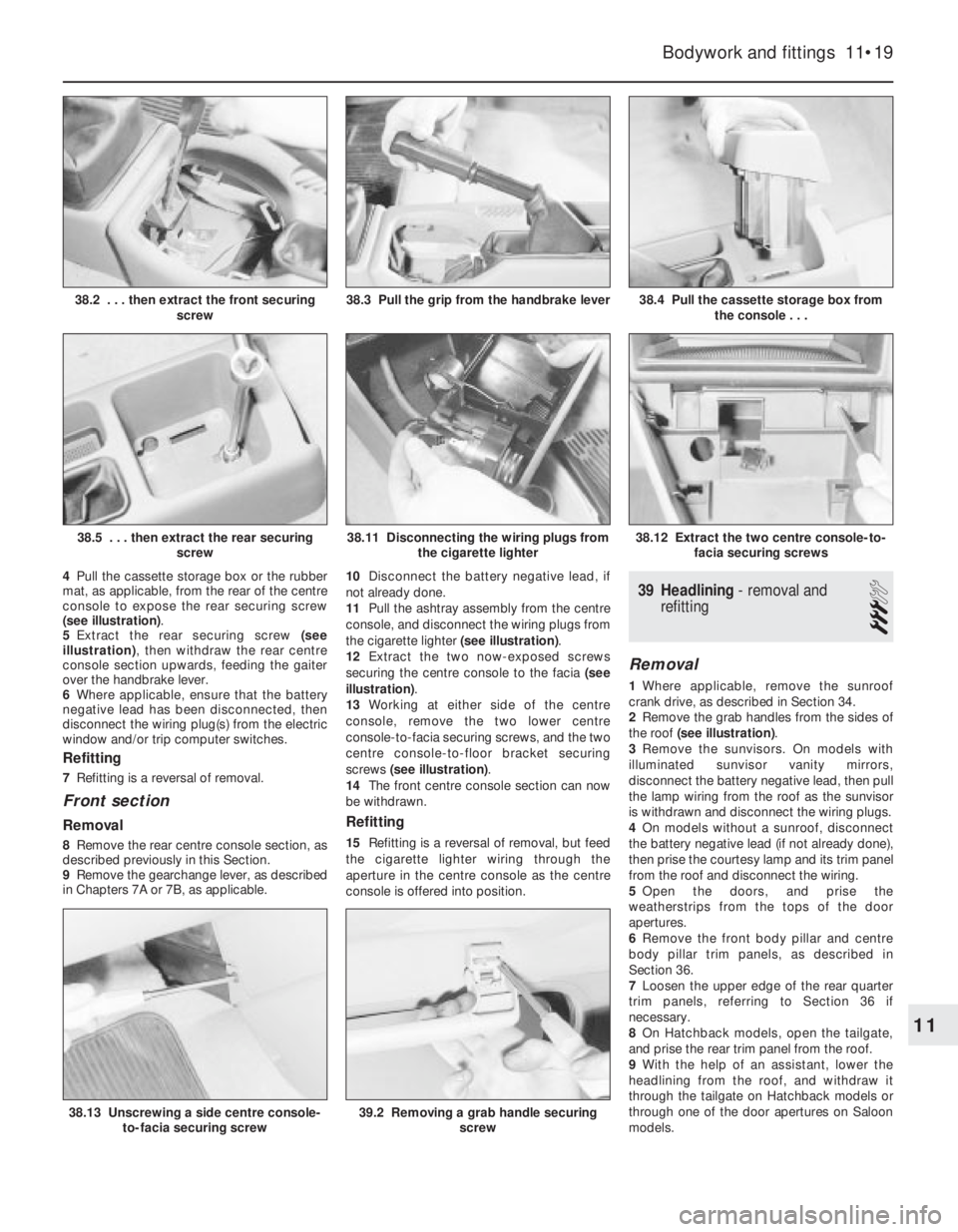
4Pull the cassette storage box or the rubber
mat, as applicable, from the rear of the centre
console to expose the rear securing screw
(see illustration).
5Extract the rear securing screw (see
illustration), then withdraw the rear centre
console section upwards, feeding the gaiter
over the handbrake lever.
6Where applicable, ensure that the battery
negative lead has been disconnected, then
disconnect the wiring plug(s) from the electric
window and/or trip computer switches.
Refitting
7Refitting is a reversal of removal.
Front section
Removal
8Remove the rear centre console section, as
described previously in this Section.
9Remove the gearchange lever, as described
in Chapters 7A or 7B, as applicable. 10Disconnect the battery negative lead, if
not already done.
11Pull the ashtray assembly from the centre
console, and disconnect the wiring plugs from
the cigarette lighter (see illustration).
12Extract the two now-exposed screws
securing the centre console to the facia (see
illustration).
13Working at either side of the centre
console, remove the two lower centre
console-to-facia securing screws, and the two
centre console-to-floor bracket securing
screws (see illustration).
14The front centre console section can now
be withdrawn.
Refitting
15Refitting is a reversal of removal, but feed
the cigarette lighter wiring through the
aperture in the centre console as the centre
console is offered into position.
39Headlining -removal and
refitting
3
Removal
1Where applicable, remove the sunroof
crank drive, as described in Section 34.
2Remove the grab handles from the sides of
the roof (see illustration).
3Remove the sunvisors. On models with
illuminated sunvisor vanity mirrors,
disconnect the battery negative lead, then pull
the lamp wiring from the roof as the sunvisor
is withdrawn and disconnect the wiring plugs.
4On models without a sunroof, disconnect
the battery negative lead (if not already done),
then prise the courtesy lamp and its trim panel
from the roof and disconnect the wiring.
5Open the doors, and prise the
weatherstrips from the tops of the door
apertures.
6Remove the front body pillar and centre
body pillar trim panels, as described in
Section 36.
7Loosen the upper edge of the rear quarter
trim panels, referring to Section 36 if
necessary.
8On Hatchback models, open the tailgate,
and prise the rear trim panel from the roof.
9With the help of an assistant, lower the
headlining from the roof, and withdraw it
through the tailgate on Hatchback models or
through one of the door apertures on Saloon
models.
Bodywork and fittings 11•19
38.4 Pull the cassette storage box from
the console . . .
38.12 Extract the two centre console-to-
facia securing screws38.11 Disconnecting the wiring plugs from
the cigarette lighter
38.3 Pull the grip from the handbrake lever38.2 . . . then extract the front securing
screw
11
38.5 . . . then extract the rear securing
screw
38.13 Unscrewing a side centre console-
to-facia securing screw39.2 Removing a grab handle securing
screw
Page 123 of 525
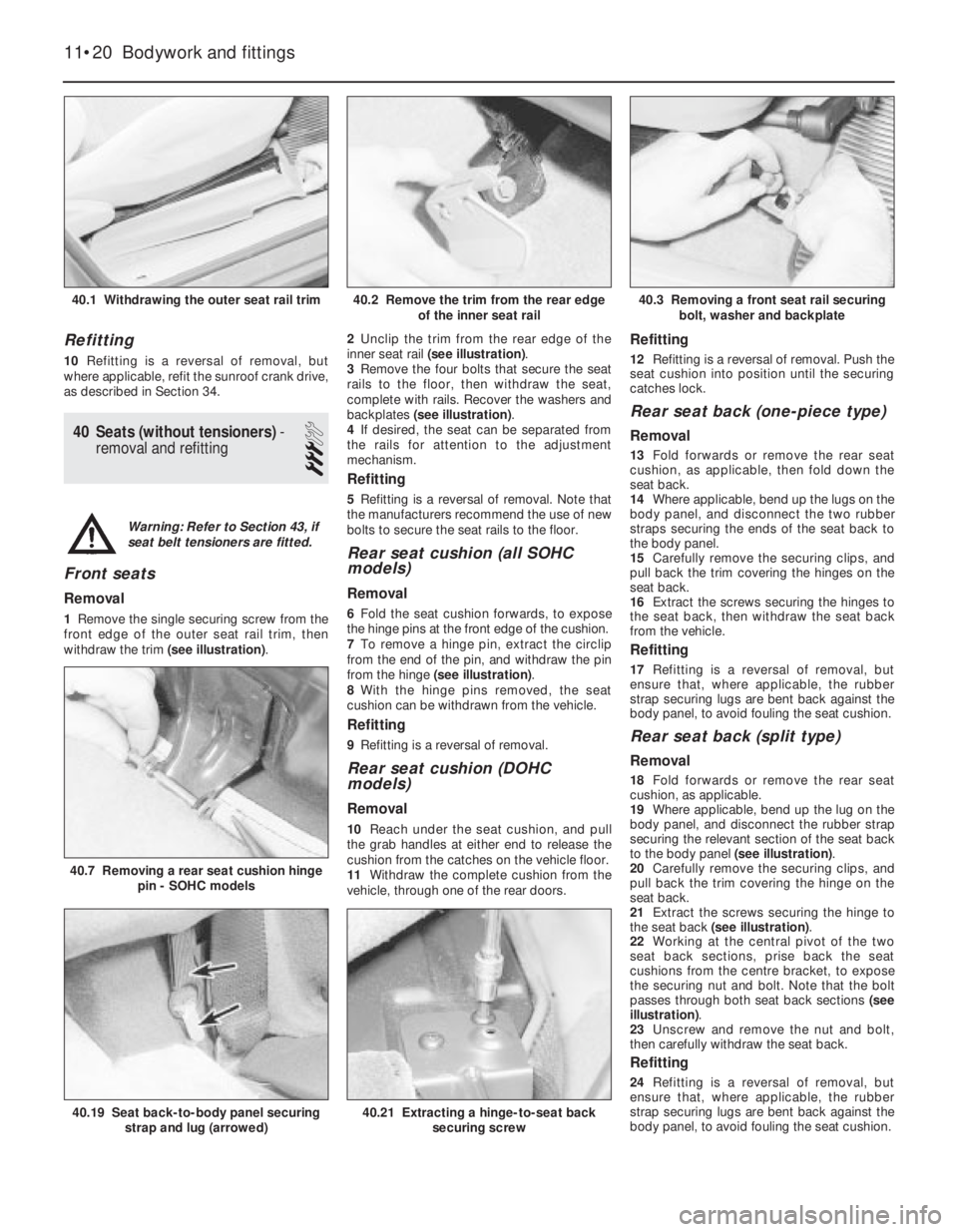
Refitting
10Refitting is a reversal of removal, but
where applicable, refit the sunroof crank drive,
as described in Section 34.
40Seats (without tensioners) -
removal and refitting
3
Front seats
Removal
1Remove the single securing screw from the
front edge of the outer seat rail trim, then
withdraw the trim (see illustration).2Unclip the trim from the rear edge of the
inner seat rail (see illustration).
3Remove the four bolts that secure the seat
rails to the floor, then withdraw the seat,
complete with rails. Recover the washers and
backplates (see illustration).
4If desired, the seat can be separated from
the rails for attention to the adjustment
mechanism.
Refitting
5Refitting is a reversal of removal. Note that
the manufacturers recommend the use of new
bolts to secure the seat rails to the floor.
Rear seat cushion (all SOHC
models)
Removal
6Fold the seat cushion forwards, to expose
the hinge pins at the front edge of the cushion.
7To remove a hinge pin, extract the circlip
from the end of the pin, and withdraw the pin
from the hinge (see illustration).
8With the hinge pins removed, the seat
cushion can be withdrawn from the vehicle.
Refitting
9Refitting is a reversal of removal.
Rear seat cushion (DOHC
models)
Removal
10Reach under the seat cushion, and pull
the grab handles at either end to release the
cushion from the catches on the vehicle floor.
11Withdraw the complete cushion from the
vehicle, through one of the rear doors.
Refitting
12Refitting is a reversal of removal. Push the
seat cushion into position until the securing
catches lock.
Rear seat back (one-piece type)
Removal
13Fold forwards or remove the rear seat
cushion, as applicable, then fold down the
seat back.
14Where applicable, bend up the lugs on the
body panel, and disconnect the two rubber
straps securing the ends of the seat back to
the body panel.
15Carefully remove the securing clips, and
pull back the trim covering the hinges on the
seat back.
16Extract the screws securing the hinges to
the seat back, then withdraw the seat back
from the vehicle.
Refitting
17Refitting is a reversal of removal, but
ensure that, where applicable, the rubber
strap securing lugs are bent back against the
body panel, to avoid fouling the seat cushion.
Rear seat back (split type)
Removal
18Fold forwards or remove the rear seat
cushion, as applicable.
19Where applicable, bend up the lug on the
body panel, and disconnect the rubber strap
securing the relevant section of the seat back
to the body panel (see illustration).
20Carefully remove the securing clips, and
pull back the trim covering the hinge on the
seat back.
21Extract the screws securing the hinge to
the seat back (see illustration).
22Working at the central pivot of the two
seat back sections, prise back the seat
cushions from the centre bracket, to expose
the securing nut and bolt. Note that the bolt
passes through both seat back sections (see
illustration).
23Unscrew and remove the nut and bolt,
then carefully withdraw the seat back.
Refitting
24Refitting is a reversal of removal, but
ensure that, where applicable, the rubber
strap securing lugs are bent back against the
body panel, to avoid fouling the seat cushion.
11•20Bodywork and fittings
40.1 Withdrawing the outer seat rail trim40.3 Removing a front seat rail securing
bolt, washer and backplate
40.7 Removing a rear seat cushion hinge
pin - SOHC models
40.21 Extracting a hinge-to-seat back
securing screw40.19 Seat back-to-body panel securing
strap and lug (arrowed)
40.2 Remove the trim from the rear edge
of the inner seat rail
Warning: Refer to Section 43, if
seat belt tensioners are fitted.
Page 124 of 525
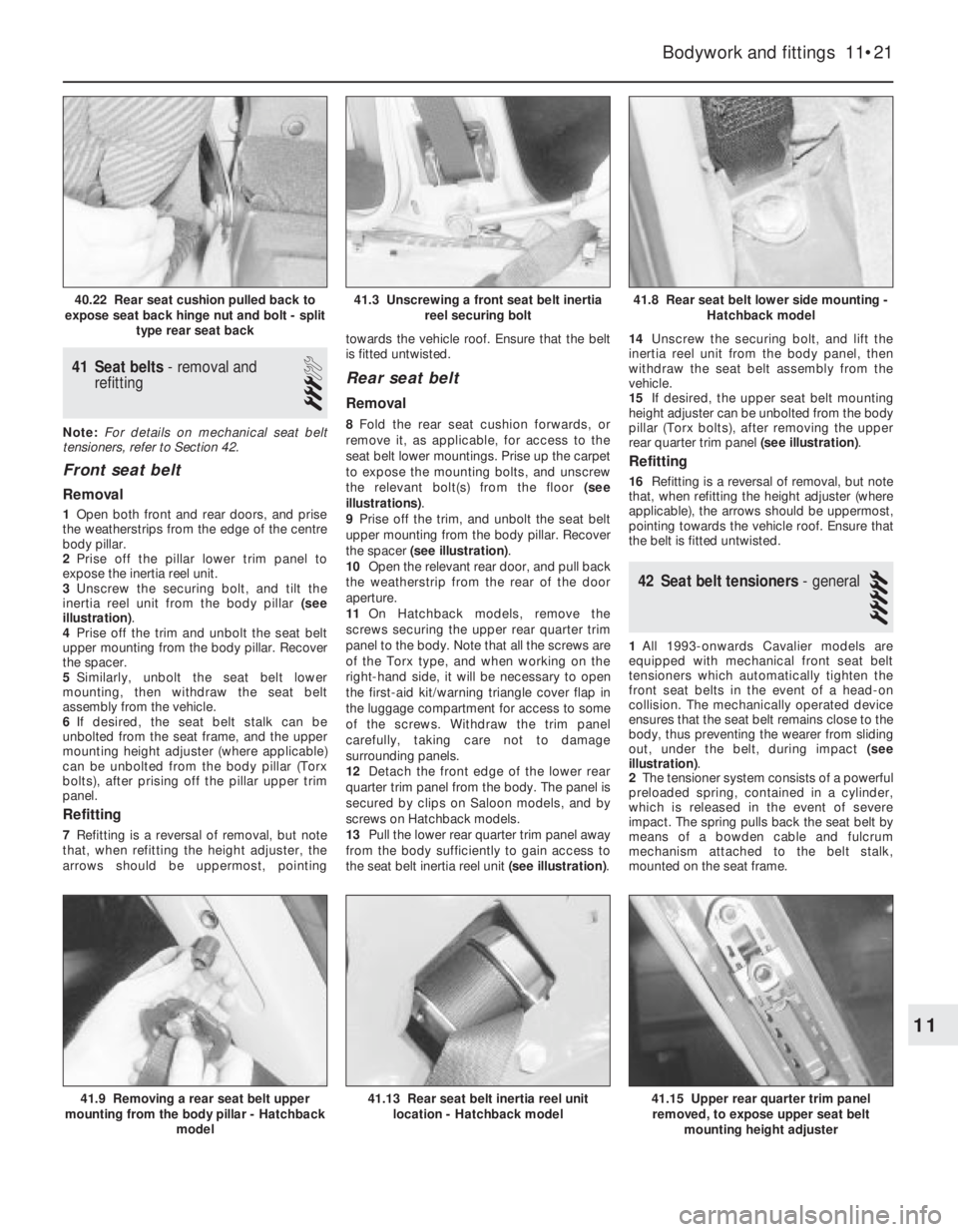
41Seat belts - removal and
refitting
3
Note: For details on mechanical seat belt
tensioners, refer to Section 42.
Front seat belt
Removal
1Open both front and rear doors, and prise
the weatherstrips from the edge of the centre
body pillar.
2Prise off the pillar lower trim panel to
expose the inertia reel unit.
3Unscrew the securing bolt, and tilt the
inertia reel unit from the body pillar (see
illustration).
4Prise off the trim and unbolt the seat belt
upper mounting from the body pillar. Recover
the spacer.
5Similarly, unbolt the seat belt lower
mounting, then withdraw the seat belt
assembly from the vehicle.
6If desired, the seat belt stalk can be
unbolted from the seat frame, and the upper
mounting height adjuster (where applicable)
can be unbolted from the body pillar (Torx
bolts), after prising off the pillar upper trim
panel.
Refitting
7Refitting is a reversal of removal, but note
that, when refitting the height adjuster, the
arrows should be uppermost, pointingtowards the vehicle roof. Ensure that the belt
is fitted untwisted.
Rear seat belt
Removal
8Fold the rear seat cushion forwards, or
remove it, as applicable, for access to the
seat belt lower mountings. Prise up the carpet
to expose the mounting bolts, and unscrew
the relevant bolt(s) from the floor (see
illustrations).
9Prise off the trim, and unbolt the seat belt
upper mounting from the body pillar. Recover
the spacer (see illustration).
10Open the relevant rear door, and pull back
the weatherstrip from the rear of the door
aperture.
11On Hatchback models, remove the
screws securing the upper rear quarter trim
panel to the body. Note that all the screws are
of the Torx type, and when working on the
right-hand side, it will be necessary to open
the first-aid kit/warning triangle cover flap in
the luggage compartment for access to some
of the screws. Withdraw the trim panel
carefully, taking care not to damage
surrounding panels.
12Detach the front edge of the lower rear
quarter trim panel from the body. The panel is
secured by clips on Saloon models, and by
screws on Hatchback models.
13Pull the lower rear quarter trim panel away
from the body sufficiently to gain access to
the seat belt inertia reel unit (see illustration).14Unscrew the securing bolt, and lift the
inertia reel unit from the body panel, then
withdraw the seat belt assembly from the
vehicle.
15If desired, the upper seat belt mounting
height adjuster can be unbolted from the body
pillar (Torx bolts), after removing the upper
rear quarter trim panel (see illustration).
Refitting
16Refitting is a reversal of removal, but note
that, when refitting the height adjuster (where
applicable), the arrows should be uppermost,
pointing towards the vehicle roof. Ensure that
the belt is fitted untwisted.
42Seat belt tensioners - general
5
1All 1993-onwards Cavalier models are
equipped with mechanical front seat belt
tensioners which automatically tighten the
front seat belts in the event of a head-on
collision. The mechanically operated device
ensures that the seat belt remains close to the
body, thus preventing the wearer from sliding
out, under the belt, during impact (see
illustration).
2The tensioner system consists of a powerful
preloaded spring, contained in a cylinder,
which is released in the event of severe
impact. The spring pulls back the seat belt by
means of a bowden cable and fulcrum
mechanism attached to the belt stalk,
mounted on the seat frame.
Bodywork and fittings 11•21
41.8 Rear seat belt lower side mounting -
Hatchback model
41.15 Upper rear quarter trim panel
removed, to expose upper seat belt
mounting height adjuster41.13 Rear seat belt inertia reel unit
location - Hatchback model41.9 Removing a rear seat belt upper
mounting from the body pillar - Hatchback
model
41.3 Unscrewing a front seat belt inertia
reel securing bolt40.22 Rear seat cushion pulled back to
expose seat back hinge nut and bolt - split
type rear seat back
11
Page 125 of 525
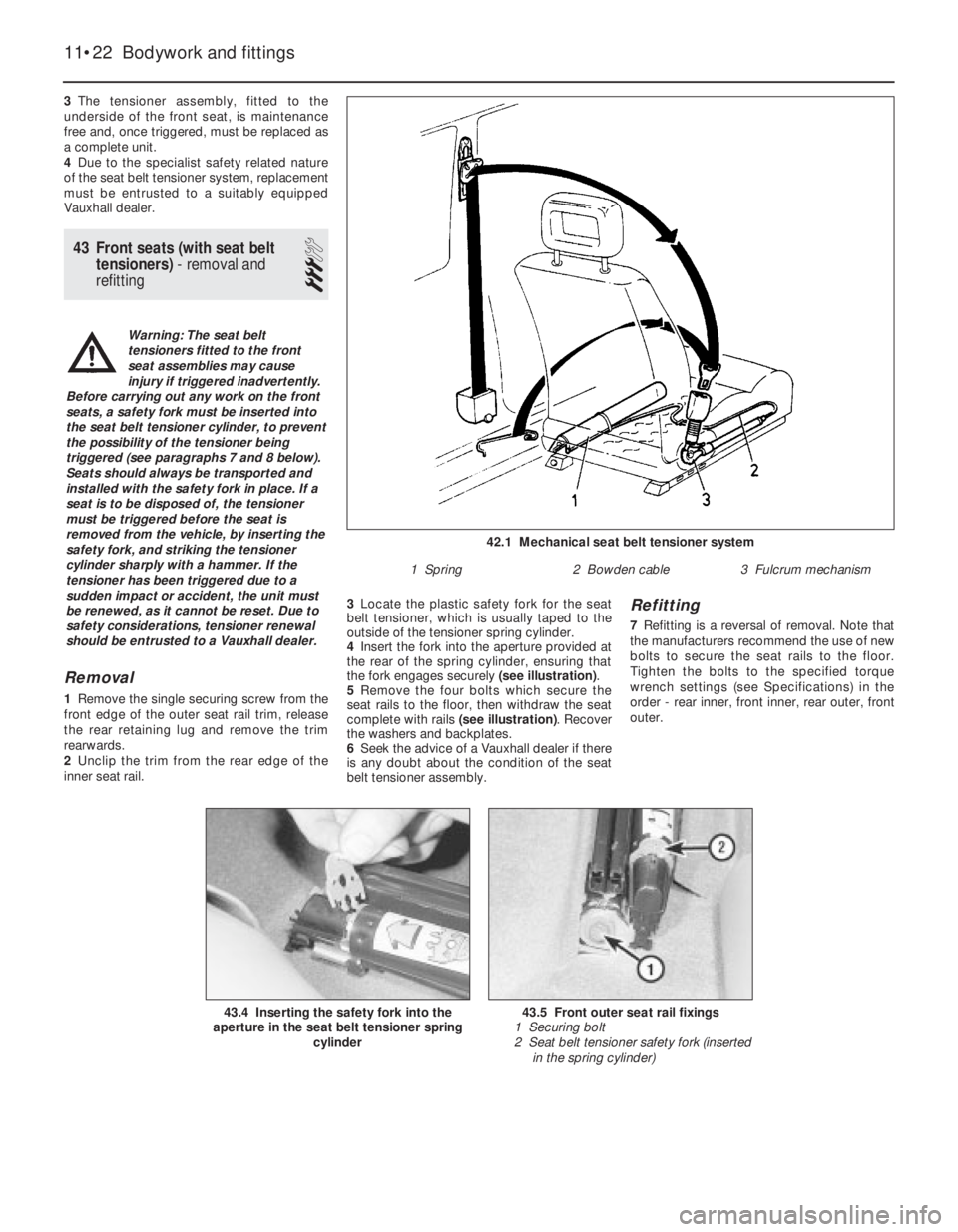
3The tensioner assembly, fitted to the
underside of the front seat, is maintenance
free and, once triggered, must be replaced as
a complete unit.
4Due to the specialist safety related nature
of the seat belt tensioner system, replacement
must be entrusted to a suitably equipped
Vauxhall dealer.
43Front seats (with seat belt
tensioners) -removal and
refitting
3
Removal
1Remove the single securing screw from the
front edge of the outer seat rail trim, release
the rear retaining lug and remove the trim
rearwards.
2Unclip the trim from the rear edge of the
inner seat rail.3Locate the plastic safety fork for the seat
belt tensioner, which is usually taped to the
outside of the tensioner spring cylinder.
4Insert the fork into the aperture provided at
the rear of the spring cylinder, ensuring that
the fork engages securely (see illustration).
5Remove the four bolts which secure the
seat rails to the floor, then withdraw the seat
complete with rails (see illustration). Recover
the washers and backplates.
6Seek the advice of a Vauxhall dealer if there
is any doubt about the condition of the seat
belt tensioner assembly.
Refitting
7Refitting is a reversal of removal. Note that
the manufacturers recommend the use of new
bolts to secure the seat rails to the floor.
Tighten the bolts to the specified torque
wrench settings (see Specifications) in the
order - rear inner, front inner, rear outer, front
outer.
11•22Bodywork and fittings
42.1 Mechanical seat belt tensioner system
1 Spring2 Bowden cable3 Fulcrum mechanism
43.5 Front outer seat rail fixings
1 Securing bolt
2 Seat belt tensioner safety fork (inserted
in the spring cylinder)43.4 Inserting the safety fork into the
aperture in the seat belt tensioner spring
cylinder
Warning: The seat belt
tensioners fitted to the front
seat assemblies may cause
injury if triggered inadvertently.
Before carrying out any work on the front
seats, a safety fork must be inserted into
the seat belt tensioner cylinder, to prevent
the possibility of the tensioner being
triggered (see paragraphs 7 and 8 below).
Seats should always be transported and
installed with the safety fork in place. If a
seat is to be disposed of, the tensioner
must be triggered before the seat is
removed from the vehicle, by inserting the
safety fork, and striking the tensioner
cylinder sharply with a hammer. If the
tensioner has been triggered due to a
sudden impact or accident, the unit must
be renewed, as it cannot be reset. Due to
safety considerations, tensioner renewal
should be entrusted to a Vauxhall dealer.
Page 126 of 525
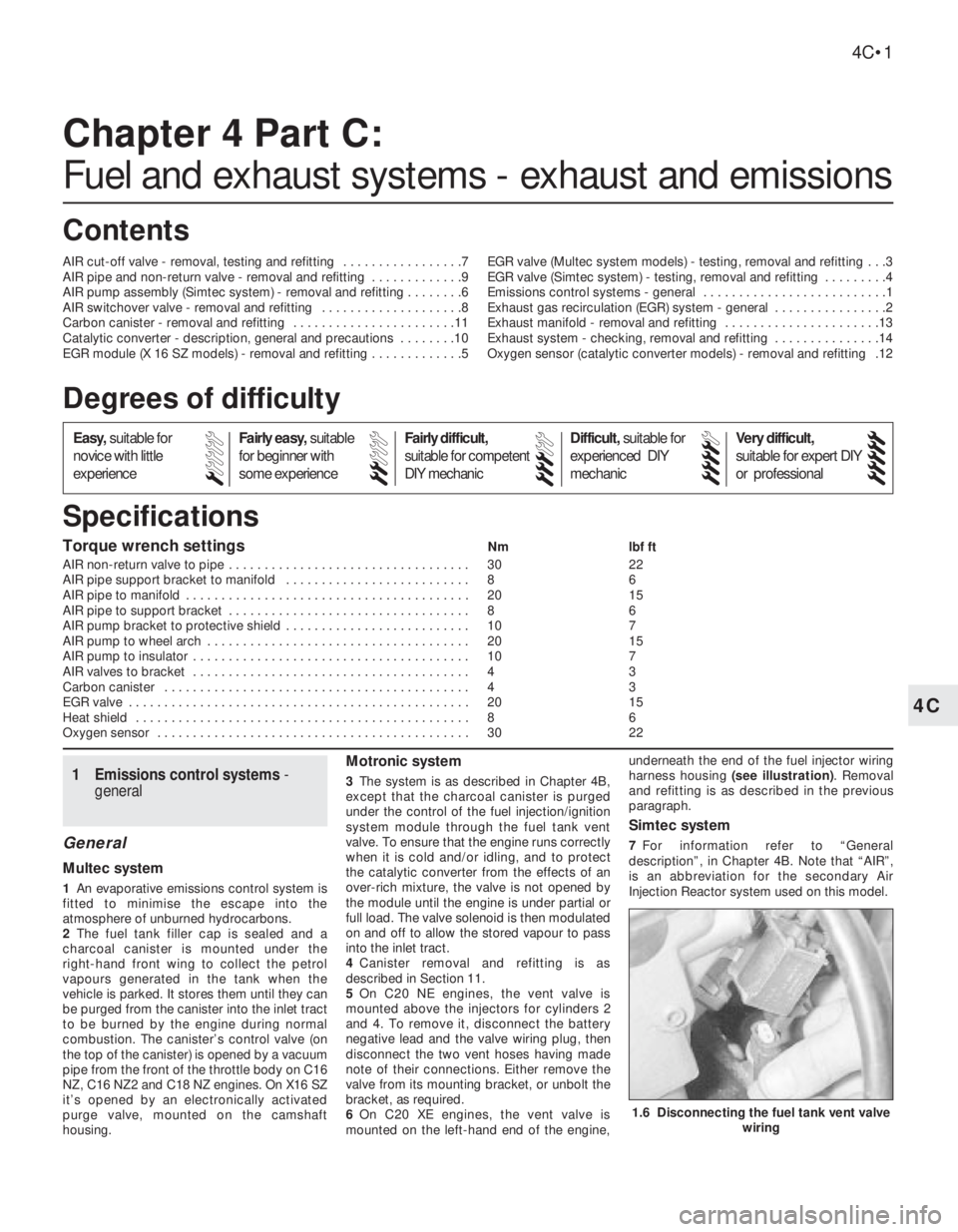
4C
Torque wrench settingsNm lbf ft
AIR non-return valve to pipe . . . . . . . . . . . . . . . . . . . . . . . . . . . . . . . . . . 30 22
AIR pipe support bracket to manifold . . . . . . . . . . . . . . . . . . . . . . . . . . 8 6
AIR pipe to manifold . . . . . . . . . . . . . . . . . . . . . . . . . . . . . . . . . . . . . . . . 20 15
AIR pipe to support bracket . . . . . . . . . . . . . . . . . . . . . . . . . . . . . . . . . . 8 6
AIR pump bracket to protective shield . . . . . . . . . . . . . . . . . . . . . . . . . . 10 7
AIR pump to wheel arch . . . . . . . . . . . . . . . . . . . . . . . . . . . . . . . . . . . . . 20 15
AIR pump to insulator . . . . . . . . . . . . . . . . . . . . . . . . . . . . . . . . . . . . . . . 10 7
AIR valves to bracket . . . . . . . . . . . . . . . . . . . . . . . . . . . . . . . . . . . . . . . 4 3
Carbon canister . . . . . . . . . . . . . . . . . . . . . . . . . . . . . . . . . . . . . . . . . . . 4 3
EGR valve . . . . . . . . . . . . . . . . . . . . . . . . . . . . . . . . . . . . . . . . . . . . . . . . 20 15
Heat shield . . . . . . . . . . . . . . . . . . . . . . . . . . . . . . . . . . . . . . . . . . . . . . . 8 6
Oxygen sensor . . . . . . . . . . . . . . . . . . . . . . . . . . . . . . . . . . . . . . . . . . . . 30 22
Chapter 4 Part C:
Fuel and exhaust systems - exhaust and emissions
AIR cut-off valve - removal, testing and refitting . . . . . . . . . . . . . . . . .7
AIR pipe and non-return valve - removal and refitting . . . . . . . . . . . . .9
AIR pump assembly (Simtec system) - removal and refitting . . . . . . . .6
AIR switchover valve - removal and refitting . . . . . . . . . . . . . . . . . . . .8
Carbon canister - removal and refitting . . . . . . . . . . . . . . . . . . . . . . .11
Catalytic converter - description, general and precautions . . . . . . . .10
EGR module (X 16 SZ models) - removal and refitting . . . . . . . . . . . . .5EGR valve (Multec system models) - testing, removal and refitting . . .3
EGR valve (Simtec system) - testing, removal and refitting . . . . . . . . .4
Emissions control systems - general . . . . . . . . . . . . . . . . . . . . . . . . . .1
Exhaust gas recirculation (EGR) system - general . . . . . . . . . . . . . . . .2
Exhaust manifold - removal and refitting . . . . . . . . . . . . . . . . . . . . . .13
Exhaust system - checking, removal and refitting . . . . . . . . . . . . . . .14
Oxygen sensor (catalytic converter models) - removal and refitting .12
4C•1
Specifications Contents
1 Emissions control systems -
general
General
Multec system
1An evaporative emissions control system is
fitted to minimise the escape into the
atmosphere of unburned hydrocarbons.
2The fuel tank filler cap is sealed and a
charcoal canister is mounted under the
right-hand front wing to collect the petrol
vapours generated in the tank when the
vehicle is parked. It stores them until they can
be purged from the canister into the inlet tract
to be burned by the engine during normal
combustion. The canister’s control valve (on
the top of the canister) is opened by a vacuum
pipe from the front of the throttle body on C16
NZ, C16 NZ2 and C18 NZ engines. On X16 SZ
it’s opened by an electronically activated
purge valve, mounted on the camshaft
housing.
Motronic system
3The system is as described in Chapter 4B,
except that the charcoal canister is purged
under the control of the fuel injection/ignition
system module through the fuel tank vent
valve. To ensure that the engine runs correctly
when it is cold and/or idling, and to protect
the catalytic converter from the effects of an
over-rich mixture, the valve is not opened by
the module until the engine is under partial or
full load. The valve solenoid is then modulated
on and off to allow the stored vapour to pass
into the inlet tract.
4Canister removal and refitting is as
described in Section 11.
5On C20 NE engines, the vent valve is
mounted above the injectors for cylinders 2
and 4. To remove it, disconnect the battery
negative lead and the valve wiring plug, then
disconnect the two vent hoses having made
note of their connections. Either remove the
valve from its mounting bracket, or unbolt the
bracket, as required.
6On C20 XE engines, the vent valve is
mounted on the left-hand end of the engine,underneath the end of the fuel injector wiring
harness housing (see illustration). Removal
and refitting is as described in the previous
paragraph.
Simtec system
7For information refer to “General
description”, in Chapter 4B. Note that “AIR”,
is an abbreviation for the secondary Air
Injection Reactor system used on this model.
Easy,suitable for
novice with little
experienceFairly easy,suitable
for beginner with
some experienceFairly difficult,
suitable for competent
DIY mechanic
Difficult,suitable for
experienced DIY
mechanicVery difficult,
suitable for expert DIY
or professional
Degrees of difficulty
54321
1.6 Disconnecting the fuel tank vent valve
wiring
Page 127 of 525
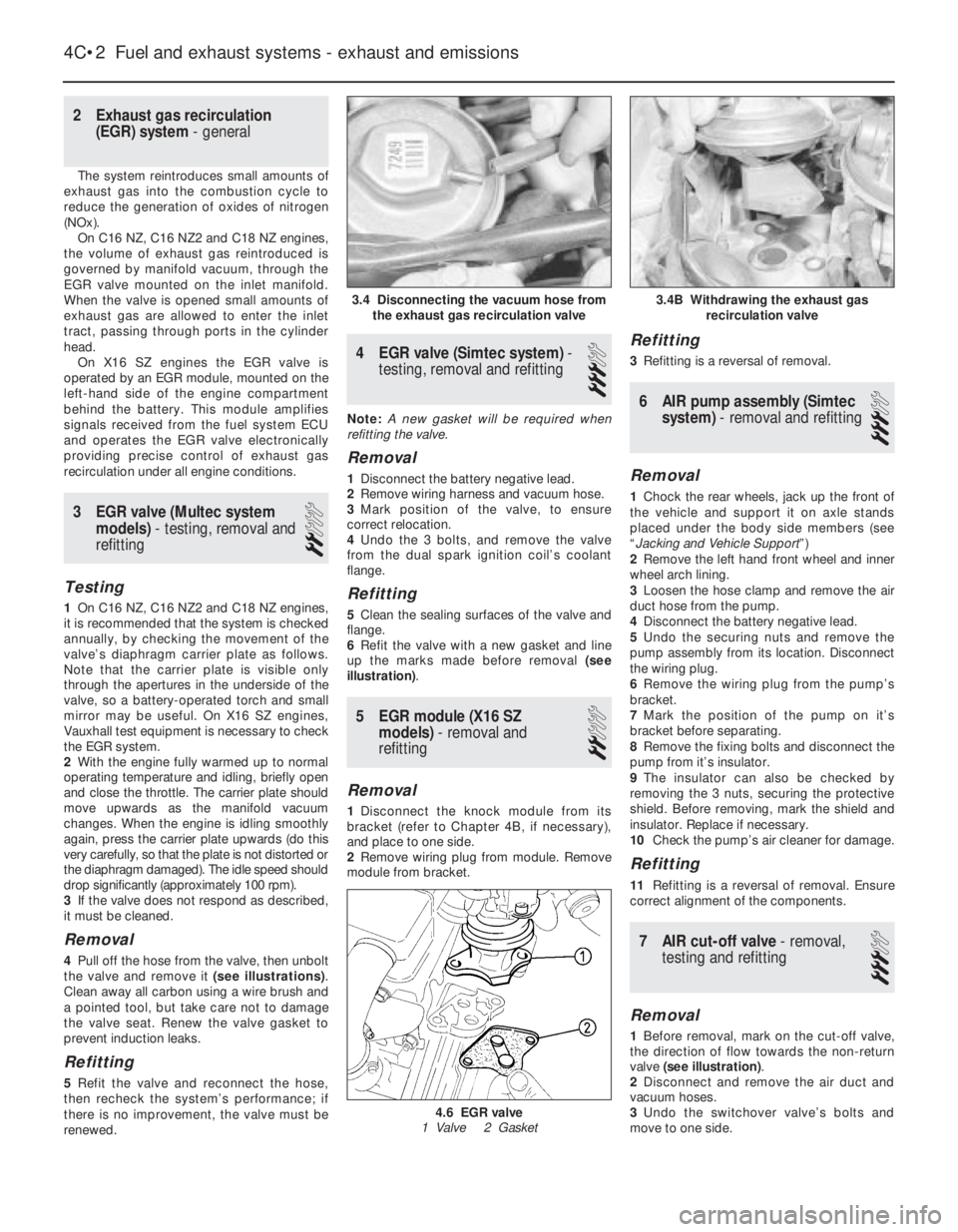
2Exhaust gas recirculation
(EGR) system - general
The system reintroduces small amounts of
exhaust gas into the combustion cycle to
reduce the generation of oxides of nitrogen
(NOx).
On C16 NZ, C16 NZ2 and C18 NZ engines,
the volume of exhaust gas reintroduced is
governed by manifold vacuum, through the
EGR valve mounted on the inlet manifold.
When the valve is opened small amounts of
exhaust gas are allowed to enter the inlet
tract, passing through ports in the cylinder
head.
On X16 SZ engines the EGR valve is
operated by an EGR module, mounted on the
left-hand side of the engine compartment
behind the battery. This module amplifies
signals received from the fuel system ECU
and operates the EGR valve electronically
providing precise control of exhaust gas
recirculation under all engine conditions.
3EGR valve (Multec system
models) - testing, removal and
refitting
2
Testing
1On C16 NZ, C16 NZ2 and C18 NZ engines,
it is recommended that the system is checked
annually, by checking the movement of the
valve’s diaphragm carrier plate as follows.
Note that the carrier plate is visible only
through the apertures in the underside of the
valve, so a battery-operated torch and small
mirror may be useful. On X16 SZ engines,
Vauxhall test equipment is necessary to check
the EGR system.
2With the engine fully warmed up to normal
operating temperature and idling, briefly open
and close the throttle. The carrier plate should
move upwards as the manifold vacuum
changes. When the engine is idling smoothly
again, press the carrier plate upwards (do this
very carefully, so that the plate is not distorted or
the diaphragm damaged). The idle speed should
drop significantly (approximately 100 rpm).
3If the valve does not respond as described,
it must be cleaned.
Removal
4Pull off the hose from the valve, then unbolt
the valve and remove it (see illustrations).
Clean away all carbon using a wire brush and
a pointed tool, but take care not to damage
the valve seat. Renew the valve gasket to
prevent induction leaks.
Refitting
5Refit the valve and reconnect the hose,
then recheck the system’s performance; if
there is no improvement, the valve must be
renewed.
4EGR valve (Simtec system) -
testing, removal and refitting
3
Note: A new gasket will be required when
refitting the valve.
Removal
1Disconnect the battery negative lead.
2Remove wiring harness and vacuum hose.
3Mark position of the valve, to ensure
correct relocation.
4Undo the 3 bolts, and remove the valve
from the dual spark ignition coil’s coolant
flange.
Refitting
5Clean the sealing surfaces of the valve and
flange.
6Refit the valve with a new gasket and line
up the marks made before removal (see
illustration).
5EGR module (X16 SZ
models) - removal and
refitting
2
Removal
1Disconnect the knock module from its
bracket (refer to Chapter 4B, if necessary),
and place to one side.
2Remove wiring plug from module. Remove
module from bracket.
Refitting
3Refitting is a reversal of removal.
6AIR pump assembly (Simtec
system) - removal and refitting
3
Removal
1Chock the rear wheels, jack up the front of
the vehicle and support it on axle stands
placed under the body side members (see
“Jacking and Vehicle Support”)
2Remove the left hand front wheel and inner
wheel arch lining.
3Loosen the hose clamp and remove the air
duct hose from the pump.
4Disconnect the battery negative lead.
5Undo the securing nuts and remove the
pump assembly from its location. Disconnect
the wiring plug.
6Remove the wiring plug from the pump’s
bracket.
7Mark the position of the pump on it’s
bracket before separating.
8Remove the fixing bolts and disconnect the
pump from it’s insulator.
9The insulator can also be checked by
removing the 3 nuts, securing the protective
shield. Before removing, mark the shield and
insulator. Replace if necessary.
10Check the pump’s air cleaner for damage.
Refitting
11Refitting is a reversal of removal. Ensure
correct alignment of the components.
7AIR cut-off valve - removal,
testing and refitting
3
Removal
1Before removal, mark on the cut-off valve,
the direction of flow towards the non-return
valve (see illustration).
2Disconnect and remove the air duct and
vacuum hoses.
3Undo the switchover valve’s bolts and
move to one side.
4C•2Fuel and exhaust systems - exhaust and emissions
3.4 Disconnecting the vacuum hose from
the exhaust gas recirculation valve
4.6 EGR valve
1 Valve 2 Gasket
3.4B Withdrawing the exhaust gas
recirculation valve
Page 128 of 525
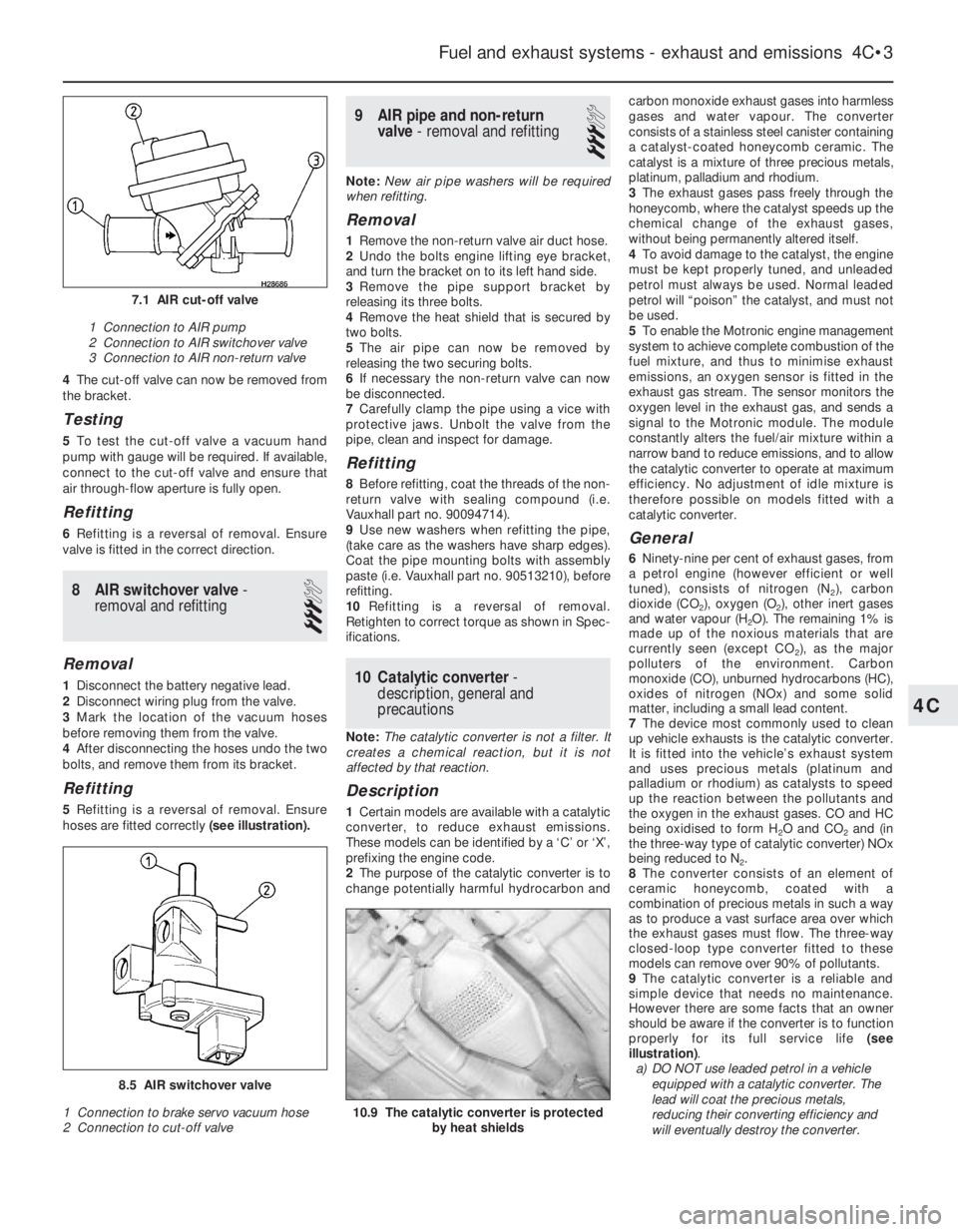
4The cut-off valve can now be removed from
the bracket.
Testing
5To test the cut-off valve a vacuum hand
pump with gauge will be required. If available,
connect to the cut-off valve and ensure that
air through-flow aperture is fully open.
Refitting
6Refitting is a reversal of removal. Ensure
valve is fitted in the correct direction.
8AIR switchover valve -
removal and refitting
3
Removal
1Disconnect the battery negative lead.
2Disconnect wiring plug from the valve.
3Mark the location of the vacuum hoses
before removing them from the valve.
4After disconnecting the hoses undo the two
bolts, and remove them from its bracket.
Refitting
5Refitting is a reversal of removal. Ensure
hoses are fitted correctly (see illustration).
9AIR pipe and non-return
valve - removal and refitting
3
Note:New air pipe washers will be required
when refitting.
Removal
1Remove the non-return valve air duct hose.
2Undo the bolts engine lifting eye bracket,
and turn the bracket on to its left hand side.
3Remove the pipe support bracket by
releasing its three bolts.
4Remove the heat shield that is secured by
two bolts.
5The air pipe can now be removed by
releasing the two securing bolts.
6If necessary the non-return valve can now
be disconnected.
7Carefully clamp the pipe using a vice with
protective jaws. Unbolt the valve from the
pipe, clean and inspect for damage.
Refitting
8Before refitting, coat the threads of the non-
return valve with sealing compound (i.e.
Vauxhall part no. 90094714).
9Use new washers when refitting the pipe,
(take care as the washers have sharp edges).
Coat the pipe mounting bolts with assembly
paste (i.e. Vauxhall part no. 90513210), before
refitting.
10Refitting is a reversal of removal.
Retighten to correct torque as shown in Spec-
ifications.
10Catalytic converter -
description, general and
precautions
Note: The catalytic converter is not a filter. It
creates a chemical reaction, but it is not
affected by that reaction.
Description
1Certain models are available with a catalytic
converter, to reduce exhaust emissions.
These models can be identified by a ‘C’ or ‘X’,
prefixing the engine code.
2The purpose of the catalytic converter is to
change potentially harmful hydrocarbon andcarbon monoxide exhaust gases into harmless
gases and water vapour. The converter
consists of a stainless steel canister containing
a catalyst-coated honeycomb ceramic. The
catalyst is a mixture of three precious metals,
platinum, palladium and rhodium.
3The exhaust gases pass freely through the
honeycomb, where the catalyst speeds up the
chemical change of the exhaust gases,
without being permanently altered itself.
4To avoid damage to the catalyst, the engine
must be kept properly tuned, and unleaded
petrol must always be used. Normal leaded
petrol will “poison” the catalyst, and must not
be used.
5To enable the Motronic engine management
system to achieve complete combustion of the
fuel mixture, and thus to minimise exhaust
emissions, an oxygen sensor is fitted in the
exhaust gas stream. The sensor monitors the
oxygen level in the exhaust gas, and sends a
signal to the Motronic module. The module
constantly alters the fuel/air mixture within a
narrow band to reduce emissions, and to allow
the catalytic converter to operate at maximum
efficiency. No adjustment of idle mixture is
therefore possible on models fitted with a
catalytic converter.
General
6Ninety-nine per cent of exhaust gases, from
a petrol engine (however efficient or well
tuned), consists of nitrogen (N
2), carbon
dioxide (CO
2), oxygen (O2), other inert gases
and water vapour (H
2O). The remaining 1% is
made up of the noxious materials that are
currently seen (except CO
2), as the major
polluters of the environment. Carbon
monoxide (CO), unburned hydrocarbons (HC),
oxides of nitrogen (NOx) and some solid
matter, including a small lead content.
7The device most commonly used to clean
up vehicle exhausts is the catalytic converter.
It is fitted into the vehicle’s exhaust system
and uses precious metals (platinum and
palladium or rhodium) as catalysts to speed
up the reaction between the pollutants and
the oxygen in the exhaust gases. CO and HC
being oxidised to form H
2O and CO2and (in
the three-way type of catalytic converter) NOx
being reduced to N
2.
8The converter consists of an element of
ceramic honeycomb, coated with a
combination of precious metals in such a way
as to produce a vast surface area over which
the exhaust gases must flow. The three-way
closed-loop type converter fitted to these
models can remove over 90% of pollutants.
9The catalytic converter is a reliable and
simple device that needs no maintenance.
However there are some facts that an owner
should be aware if the converter is to function
properly for its full service life (see
illustration).
a)DO NOT use leaded petrol in a vehicle
equipped with a catalytic converter. The
lead will coat the precious metals,
reducing their converting efficiency and
will eventually destroy the converter.
Fuel and exhaust systems - exhaust and emissions 4C•3
10.9 The catalytic converter is protected
by heat shields
8.5 AIR switchover valve
1 Connection to brake servo vacuum hose
2 Connection to cut-off valve
7.1 AIR cut-off valve
1 Connection to AIR pump
2 Connection to AIR switchover valve
3 Connection to AIR non-return valve
4C
Page 129 of 525
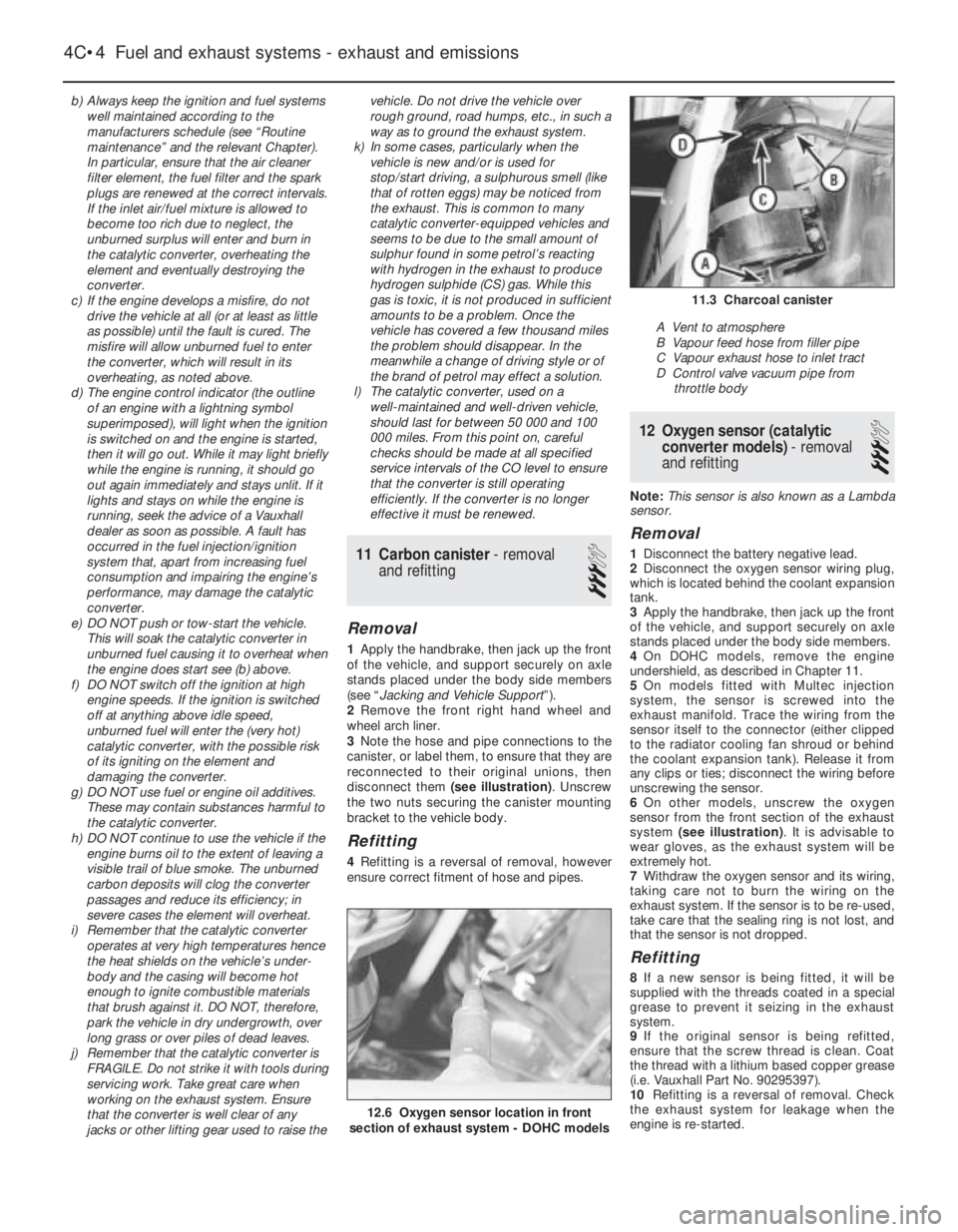
b)Always keep the ignition and fuel systems
well maintained according to the
manufacturers schedule (see “Routine
maintenance” and the relevant Chapter).
In particular, ensure that the air cleaner
filter element, the fuel filter and the spark
plugs are renewed at the correct intervals.
If the inlet air/fuel mixture is allowed to
become too rich due to neglect, the
unburned surplus will enter and burn in
the catalytic converter, overheating the
element and eventually destroying the
converter.
c)If the engine develops a misfire, do not
drive the vehicle at all (or at least as little
as possible) until the fault is cured. The
misfire will allow unburned fuel to enter
the converter, which will result in its
overheating, as noted above.
d)The engine control indicator (the outline
of an engine with a lightning symbol
superimposed), will light when the ignition
is switched on and the engine is started,
then it will go out. While it may light briefly
while the engine is running, it should go
out again immediately and stays unlit. If it
lights and stays on while the engine is
running, seek the advice of a Vauxhall
dealer as soon as possible. A fault has
occurred in the fuel injection/ignition
system that, apart from increasing fuel
consumption and impairing the engine’s
performance, may damage the catalytic
converter.
e)DO NOT push or tow-start the vehicle.
This will soak the catalytic converter in
unburned fuel causing it to overheat when
the engine does start see (b) above.
f)DO NOT switch off the ignition at high
engine speeds. If the ignition is switched
off at anything above idle speed,
unburned fuel will enter the (very hot)
catalytic converter, with the possible risk
of its igniting on the element and
damaging the converter.
g)DO NOT use fuel or engine oil additives.
These may contain substances harmful to
the catalytic converter.
h)DO NOT continue to use the vehicle if the
engine burns oil to the extent of leaving a
visible trail of blue smoke. The unburned
carbon deposits will clog the converter
passages and reduce its efficiency; in
severe cases the element will overheat.
i)Remember that the catalytic converter
operates at very high temperatures hence
the heat shields on the vehicle’s under-
body and the casing will become hot
enough to ignite combustible materials
that brush against it. DO NOT, therefore,
park the vehicle in dry undergrowth, over
long grass or over piles of dead leaves.
j)Remember that the catalytic converter is
FRAGlLE. Do not strike it with tools during
servicing work. Take great care when
working on the exhaust system. Ensure
that the converter is well clear of any
jacks or other lifting gear used to raise thevehicle. Do not drive the vehicle over
rough ground, road humps, etc., in such a
way as to ground the exhaust system.
k)In some cases, particularly when the
vehicle is new and/or is used for
stop/start driving, a sulphurous smell (like
that of rotten eggs) may be noticed from
the exhaust. This is common to many
catalytic converter-equipped vehicles and
seems to be due to the small amount of
sulphur found in some petrol’s reacting
with hydrogen in the exhaust to produce
hydrogen sulphide (CS) gas. While this
gas is toxic, it is not produced in sufficient
amounts to be a problem. Once the
vehicle has covered a few thousand miles
the problem should disappear. In the
meanwhile a change of driving style or of
the brand of petrol may effect a solution.
l)The catalytic converter, used on a
well-maintained and well-driven vehicle,
should last for between 50 000 and 100
000 miles. From this point on, careful
checks should be made at all specified
service intervals of the CO level to ensure
that the converter is still operating
efficiently. If the converter is no longer
effective it must be renewed.
11Carbon canister - removal
and refitting
3
Removal
1Apply the handbrake, then jack up the front
of the vehicle, and support securely on axle
stands placed under the body side members
(see “Jacking and Vehicle Support”).
2Remove the front right hand wheel and
wheel arch liner.
3Note the hose and pipe connections to the
canister, or label them, to ensure that they are
reconnected to their original unions, then
disconnect them (see illustration). Unscrew
the two nuts securing the canister mounting
bracket to the vehicle body.
Refitting
4Refitting is a reversal of removal, however
ensure correct fitment of hose and pipes.
12Oxygen sensor (catalytic
converter models) - removal
and refitting
3
Note: This sensor is also known as a Lambda
sensor.
Removal
1Disconnect the battery negative lead.
2Disconnect the oxygen sensor wiring plug,
which is located behind the coolant expansion
tank.
3Apply the handbrake, then jack up the front
of the vehicle, and support securely on axle
stands placed under the body side members.
4On DOHC models, remove the engine
undershield, as described in Chapter 11.
5On models fitted with Multec injection
system, the sensor is screwed into the
exhaust manifold. Trace the wiring from the
sensor itself to the connector (either clipped
to the radiator cooling fan shroud or behind
the coolant expansion tank). Release it from
any clips or ties; disconnect the wiring before
unscrewing the sensor.
6On other models, unscrew the oxygen
sensor from the front section of the exhaust
system (see illustration). It is advisable to
wear gloves, as the exhaust system will be
extremely hot.
7Withdraw the oxygen sensor and its wiring,
taking care not to burn the wiring on the
exhaust system. If the sensor is to be re-used,
take care that the sealing ring is not lost, and
that the sensor is not dropped.
Refitting
8If a new sensor is being fitted, it will be
supplied with the threads coated in a special
grease to prevent it seizing in the exhaust
system.
9If the original sensor is being refitted,
ensure that the screw thread is clean. Coat
the thread with a lithium based copper grease
(i.e. Vauxhall Part No. 90295397).
10Refitting is a reversal of removal. Check
the exhaust system for leakage when the
engine is re-started.
4C•4Fuel and exhaust systems - exhaust and emissions
12.6 Oxygen sensor location in front
section of exhaust system - DOHC models
11.3 Charcoal canister
A Vent to atmosphere
B Vapour feed hose from filler pipe
C Vapour exhaust hose to inlet tract
D Control valve vacuum pipe from
throttle body
Page 130 of 525
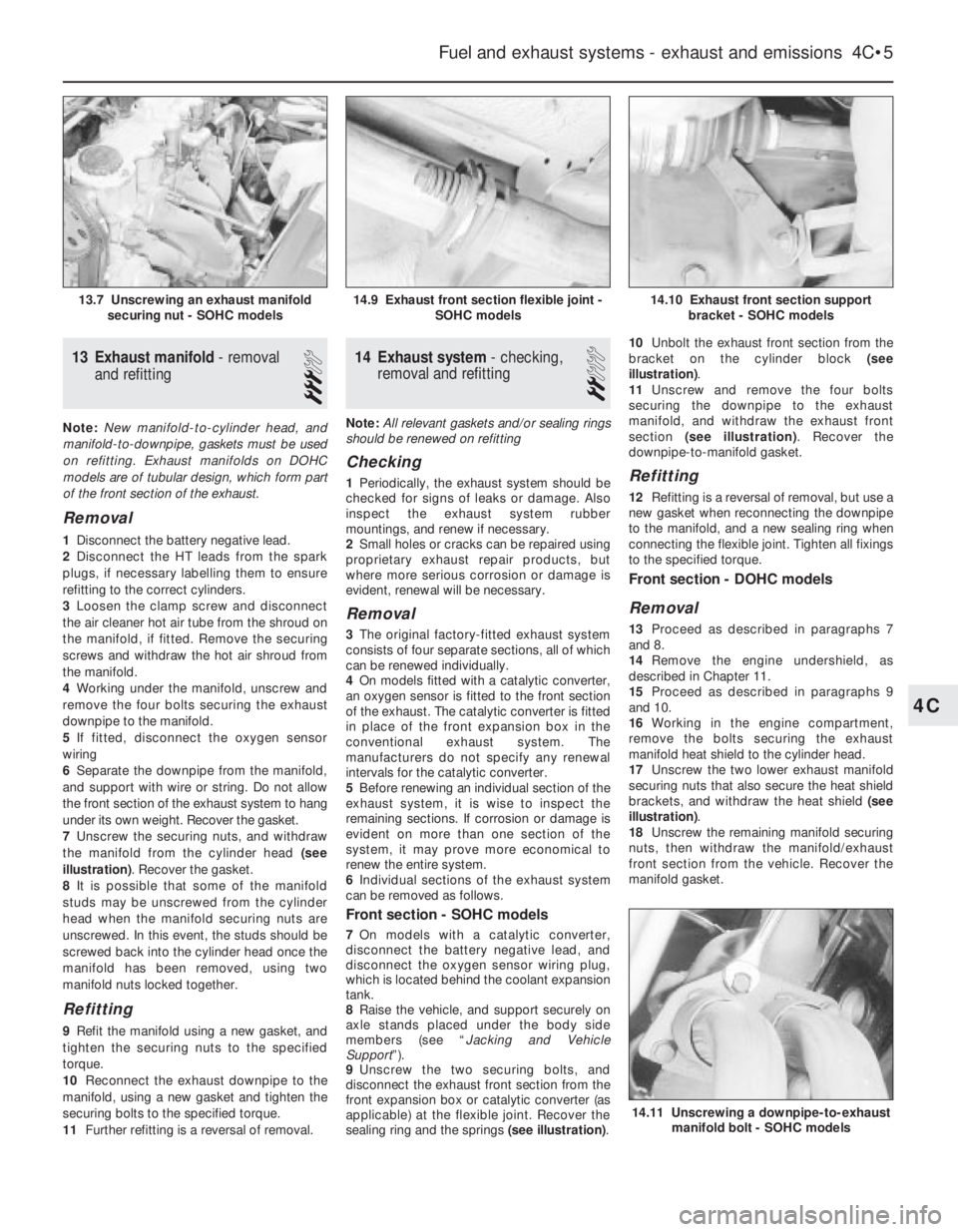
13Exhaust manifold - removal
and refitting
3
Note:New manifold-to-cylinder head, and
manifold-to-downpipe, gaskets must be used
on refitting. Exhaust manifolds on DOHC
models are of tubular design, which form part
of the front section of the exhaust.
Removal
1Disconnect the battery negative lead.
2Disconnect the HT leads from the spark
plugs, if necessary labelling them to ensure
refitting to the correct cylinders.
3Loosen the clamp screw and disconnect
the air cleaner hot air tube from the shroud on
the manifold, if fitted. Remove the securing
screws and withdraw the hot air shroud from
the manifold.
4Working under the manifold, unscrew and
remove the four bolts securing the exhaust
downpipe to the manifold.
5If fitted, disconnect the oxygen sensor
wiring
6Separate the downpipe from the manifold,
and support with wire or string. Do not allow
the front section of the exhaust system to hang
under its own weight. Recover the gasket.
7Unscrew the securing nuts, and withdraw
the manifold from the cylinder head (see
illustration). Recover the gasket.
8It is possible that some of the manifold
studs may be unscrewed from the cylinder
head when the manifold securing nuts are
unscrewed. In this event, the studs should be
screwed back into the cylinder head once the
manifold has been removed, using two
manifold nuts locked together.
Refitting
9Refit the manifold using a new gasket, and
tighten the securing nuts to the specified
torque.
10Reconnect the exhaust downpipe to the
manifold, using a new gasket and tighten the
securing bolts to the specified torque.
11Further refitting is a reversal of removal.
14Exhaust system - checking,
removal and refitting
2
Note: All relevant gaskets and/or sealing rings
should be renewed on refitting
Checking
1Periodically, the exhaust system should be
checked for signs of leaks or damage. Also
inspect the exhaust system rubber
mountings, and renew if necessary.
2Small holes or cracks can be repaired using
proprietary exhaust repair products, but
where more serious corrosion or damage is
evident, renewal will be necessary.
Removal
3The original factory-fitted exhaust system
consists of four separate sections, all of which
can be renewed individually.
4On models fitted with a catalytic converter,
an oxygen sensor is fitted to the front section
of the exhaust. The catalytic converter is fitted
in place of the front expansion box in the
conventional exhaust system. The
manufacturers do not specify any renewal
intervals for the catalytic converter.
5Before renewing an individual section of the
exhaust system, it is wise to inspect the
remaining sections. If corrosion or damage is
evident on more than one section of the
system, it may prove more economical to
renew the entire system.
6Individual sections of the exhaust system
can be removed as follows.
Front section - SOHC models
7On models with a catalytic converter,
disconnect the battery negative lead, and
disconnect the oxygen sensor wiring plug,
which is located behind the coolant expansion
tank.
8Raise the vehicle, and support securely on
axle stands placed under the body side
members (see “Jacking and Vehicle
Support”).
9Unscrew the two securing bolts, and
disconnect the exhaust front section from the
front expansion box or catalytic converter (as
applicable) at the flexible joint. Recover the
sealing ring and the springs (see illustration).10Unbolt the exhaust front section from the
bracket on the cylinder block (see
illustration).
11Unscrew and remove the four bolts
securing the downpipe to the exhaust
manifold, and withdraw the exhaust front
section (see illustration). Recover the
downpipe-to-manifold gasket.
Refitting
12Refitting is a reversal of removal, but use a
new gasket when reconnecting the downpipe
to the manifold, and a new sealing ring when
connecting the flexible joint. Tighten all fixings
to the specified torque.
Front section - DOHC models
Removal
13Proceed as described in paragraphs 7
and 8.
14Remove the engine undershield, as
described in Chapter 11.
15Proceed as described in paragraphs 9
and 10.
16Working in the engine compartment,
remove the bolts securing the exhaust
manifold heat shield to the cylinder head.
17Unscrew the two lower exhaust manifold
securing nuts that also secure the heat shield
brackets, and withdraw the heat shield (see
illustration).
18Unscrew the remaining manifold securing
nuts, then withdraw the manifold/exhaust
front section from the vehicle. Recover the
manifold gasket.
Fuel and exhaust systems - exhaust and emissions 4C•5
14.10 Exhaust front section support
bracket - SOHC models
14.11 Unscrewing a downpipe-to-exhaust
manifold bolt - SOHC models
14.9 Exhaust front section flexible joint -
SOHC models13.7 Unscrewing an exhaust manifold
securing nut - SOHC models
4C